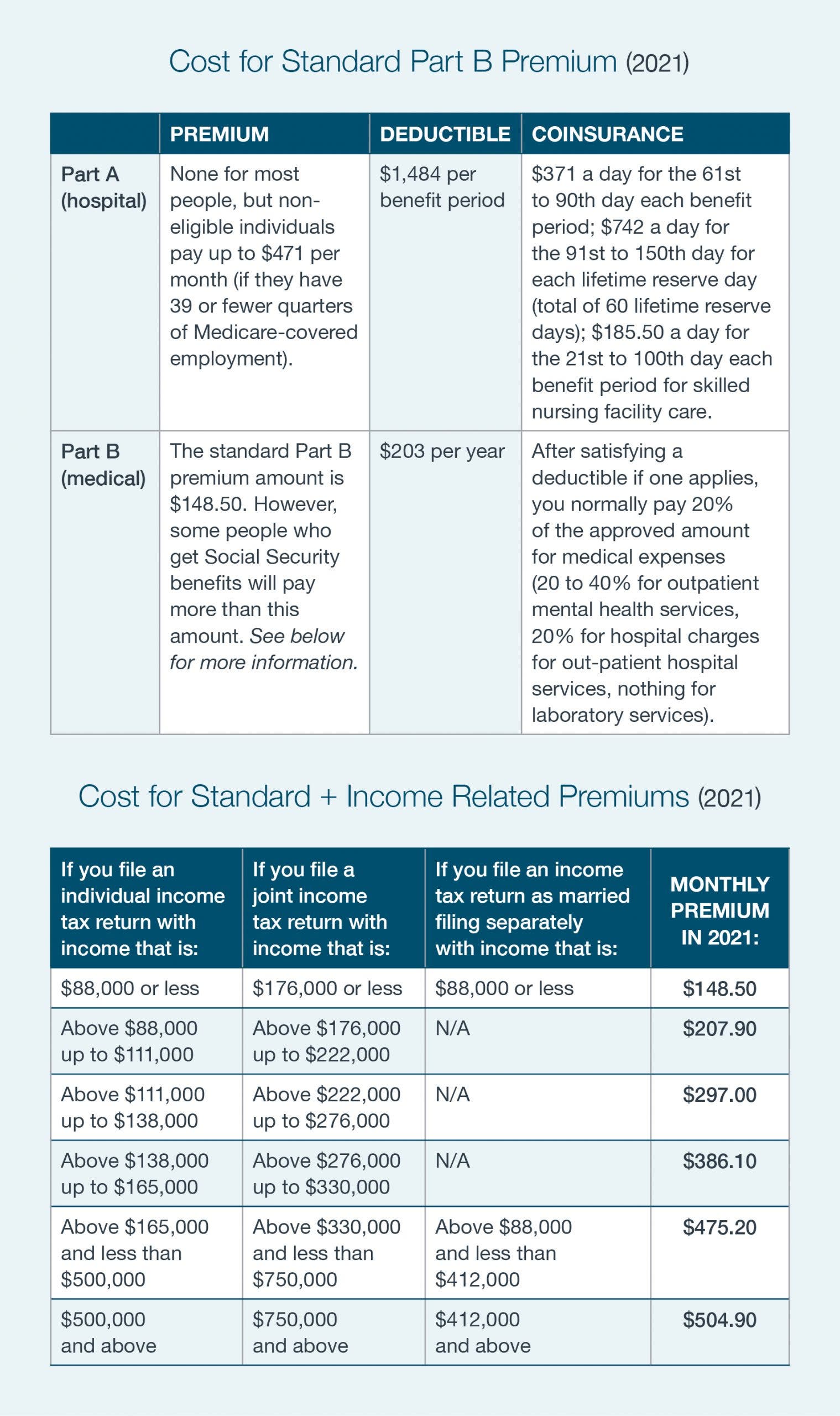
Medicare is a federal program that provides health insurance to retired individuals, regardless of their medical condition, and certain younger people with disabilities or end-stage renal disease.
Here are some basic facts about Medicare that you should know.
WHAT DOES MEDICARE COVER?
Medicare coverage consists of two main parts: Medicare Part A (hospital insurance) and Medicare Part B (medical insurance). These parts together are known as Original Medicare. A third part, Medicare Part C (Medicare Advantage), covers all Part A and Part B services, and may provide additional services. A fourth part, Medicare Part D, offers prescription drug coverage that can help you handle the rising costs of prescriptions.
MEDICARE PART A (HOSPITAL INSURANCE)
Generally known as hospital insurance, Part A covers services associated with inpatient hospital care. These are the costs associated with an overnight stay in a hospital, skilled nursing facility, or psychiatric hospital, including charges for the hospital room, meals, and nursing services. Part A also covers hospice care and home health care.
MEDICARE PART B (MEDICAL INSURANCE)
Generally known as medical insurance, Part B covers other medical care. Physician care — whether you received it as an inpatient at a hospital, as an outpatient at a hospital or other health-care facility, or at a doctor’s office — is covered under Part B. Laboratory tests, physical therapy or rehabilitation services, and ambulance service are also covered. Medicare Part B also covers 100% of the cost of many preventative services and an annual wellness visit.
Most people age 65 or older who are citizens or permanent residents of the United States are eligible for Medicare Part A (hospital insurance) without paying a monthly premium. Although Medicare Part B (medical insurance) is optional, most people sign up for it. Medicare Part B is never free — you’ll pay a monthly premium for it.
MEDICARE PART C (MEDICARE ADVANTAGE)
A Medicare Advantage plan is a private health-care plan that contracts with Medicare to provide Part A and Part B benefits. A Medicare Advantage plan covers all of the services that Original Medicare covers except hospice care. Some plans offer extra coverage for expenses not covered by Original Medicare such as vision, hearing, dental, and other health expenses. Most also offer prescription drug (Part D) coverage. Several types of Medicare Advantage plans may be available, including health maintenance organization (HMO) plans, preferred provider organization (PPO) plans, private fee-for-service (PFFS) plans, and special needs plans (SNPs). You can choose to enroll in either Original Medicare or a Medicare Advantage plan. If you enroll in a Medicare Advantage plan, you’ll generally pay a monthly premium for it, in addition to your Part B premium.
MEDICARE PART D (PRESCRIPTION DRUG COVERAGE)
All Medicare beneficiaries are eligible to join a Medicare prescription drug plan offered by private companies or insurers that have been approved by Medicare. Although these plans vary in price and benefits, they all cover a broad number of brand name and generic drugs available at local pharmacies or through the mail. Medicare prescription drug coverage is voluntary, but if you decide to join a plan, keep in mind that some plans cover more drugs or offer a wider selection of pharmacies (for a higher premium) than others.
You can get information and help with comparing plans on the Medicare website, medicare.gov, or by calling a Medicare counselor at 1-800-Medicare.
WHAT IS NOT COVERED BY MEDICARE PARTS A AND B?
Some medical expenses are not covered by either Part A or B. These expenses include:
- Your Part B premium
- Deductibles, coinsurance, or co-payments that apply
- Most prescription drugs
- Dental care
- Hearing aids
- Eye care
- Custodial care at home or in a nursing home
Medicare Part C may cover some of these expenses, or if you’re enrolled in Original Medicare you can purchase a supplemental Medigap insurance policy that will help cover what Medicare does not.
ARE YOU ELIGIBLE FOR MEDICARE?
Most people age 65 or older who are citizens or permanent residents of the United States are eligible for Medicare Part A (hospital insurance) without paying a monthly premium.
You are eligible at age 65 if:
- You receive or are eligible to receive Social Security or Railroad Retirement Board benefits based on your own work record or on someone else’s work record (as a spouse, divorced spouse, widow, widower, divorced widow, divorced widower, or parent).
- You or your spouse worked long enough in a government job where Medicare taxes were paid.
In addition, if you are under age 65, you can get Part A without paying a monthly premium if you have received Social Security or Railroad Retirement Board disability benefits for 24 months, or if you are on kidney dialysis or are a kidney transplant patient.
Even if you’re not eligible for free Part A coverage, you may still be able to purchase it by paying a premium. Call the Social Security Administration (SSA) at 800-772-1213 for more information.
Although Medicare Part B (medical insurance) is optional, most people sign up for it. If you want to join a Medicare managed care plan or a Medicare private fee-for-service plan, you’ll need to enroll in both Parts A and B. And Medicare Part B is never free — you’ll pay a monthly premium for it, even if you are eligible for premium-free Medicare Part A.
HOW MUCH DOES MEDICARE COST?
Medicare deductible amounts and premiums change annually. The tables on the right show what you’ll pay in 2021.
Most people pay the standard Part B premium of $148.50. But if your modified adjusted gross income as reported on your federal income tax return from two years ago is above a certain amount, you’ll pay the standard premium plus an extra charge called the Income Related Monthly Adjusted Amount (IRMAA).
To determine if you’re subject to income-related premiums, the SSA uses the most recent federal tax return provided by the IRS. Generally, the tax return you filed in 2020 (based on 2019 income) will be used to determine if you will pay an income-related premium in 2021. You can contact the SSA at 800-772-1213 if you have new information to report that might change the determination and lower your premium.

Since Original Medicare doesn’t cover every type of medical care, and you’ll have to pay deductibles and coinsurance, you may want to buy a Medicare supplemental insurance (Medigap) policy.
If you’re not automatically enrolled and are eligible for Medicare at age 65, you have a 7-month initial enrollment period to sign up for Part A and/or Part B.
If you’re enrolled in a Medicare Advantage plan, you’ll generally pay one monthly premium for that plan in addition to your Medicare Part B premium. Each Medicare Advantage plan has different premiums and costs for services, and coverage varies, so what you’ll pay depends on the plan you have.
WHO ADMINISTERS THE MEDICARE PROGRAM?
The Centers for Medicare & Medicaid Services (CMS) has overall responsibility for administering the Medicare program and sets standards and policies. The CMS also manages the official government website for Medicare, medicare.gov. But it’s the SSA that processes Medicare applications and answers Medicare eligibility questions.
HOW DO YOU SIGN UP FOR MEDICARE?
You’ll generally be automatically enrolled in Medicare when you turn 65 if you’re already been receiving Social Security or Railroad Retirement Board benefits for at least four months before you turn 65. The SSA will notify you that you’re being enrolled. If you’re not automatically enrolled and are eligible for Medicare at age 65, you have a 7-month initial enrollment period to sign up for Part A and/or Part B.
Although there’s no cost to enroll in Medicare Part A, you’ll pay a premium to enroll in Medicare Part B. If you’ve been automatically enrolled in Part B, you’ll be notified that you have a certain amount of time after your enrollment date to decline coverage. Even if you decide not to enroll in Medicare Part B during the initial enrollment period, you can enroll later during the annual general enrollment period that runs from January 1 to March 31 each year. However, you may pay a slightly higher premium as a result, depending on the circumstances.
If you decide to postpone applying for Social Security past your 65th birthday, you can still enroll in Medicare when you turn 65. The SSA suggests that you call 800-772-1213 three months before you turn 65 to discuss your options. The easiest way to apply for Medicare is online at ssa.gov/benefits/medicare.
THAD ISMART
CFP®, CEPS
Senior Financial Planner
tismart@bwfa.com


